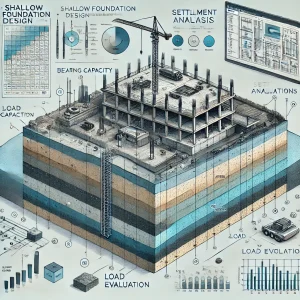Shallow foundations are a cornerstone of civil engineering projects, providing essential support for structures by transferring loads to the earth near the surface. For geotechnical engineers, the challenge lies in designing foundations that are both safe and cost-effective, while accounting for complex soil behaviors and load conditions. This is where GEO5 software emerges as a powerful ally, offering specialized tools to streamline and enhance the design process.
The Importance of Accurate Shallow Foundation Design
Designing shallow foundations involves several critical considerations:
- Soil Investigation: Understanding soil properties like bearing capacity, compressibility, and groundwater conditions is fundamental.
- Bearing Capacity Calculation: Accurate assessment prevents shear failure and excessive settlement.
- Settlement Analysis: Predicting immediate and long-term settlements ensures structural integrity.
- Load Evaluation: Incorporating various load types—dead, live, wind, seismic—is essential.
- Compliance with Standards: Adherence to local and international codes guarantees safety and legality.
Traditional methods can be time-consuming and prone to errors. GEO5 software addresses these challenges by providing comprehensive modules tailored for geotechnical tasks.
GEO5 Software: A Suite of Solutions for Shallow Foundations
Developed by Fine Software, GEO5 is a collection of geotechnical programs that cover a wide range of analyses. For shallow foundation design, the following modules are particularly beneficial:
1. GEO5 Spread Footing
GEO5 Spread Footing is dedicated to the design and assessment of spread (isolated) footings.
- Bearing Capacity Analysis: Utilize methods like Terzaghi, Meyerhof, and Eurocode 7 to calculate ultimate bearing capacity.
- Settlement Calculations: Predict immediate and consolidation settlements using soil compressibility data.
- Structural Design: Determine reinforcement requirements for bending moments and shear forces.
- User-Friendly Interface: Input data and obtain results efficiently, with graphical outputs enhancing understanding.
2. GEO5 Spread Footing CPT
GEO5 Spread Footing CPT integrates Cone Penetration Test data directly into the foundation design process.
- Direct CPT Data Utilization: Import CPT results to define soil stratigraphy and properties accurately.
- Enhanced Bearing Capacity: Use real-time data to refine calculations, increasing reliability.
- Efficiency: Reduce manual data processing, minimizing errors and saving time.
3. GEO5 Plate
GEO5 Plate is ideal for the analysis of raft (mat) foundations and slabs.
- 2D and 3D Modeling: Create detailed models that simulate the foundation and soil interaction.
- Settlement Analysis: Evaluate both uniform and differential settlements across the foundation area.
- Load Combination Handling: Assess the foundation under various loading scenarios to ensure robustness.
4. GEO5 Beam
GEO5 Beam focuses on the analysis of beams on elastic foundations, such as strip footings.
- Elastic Foundation Modeling: Simulate soil behavior using Winkler or Pasternak models.
- Comprehensive Analysis: Calculate deflections, internal forces, and stresses within the beam.
- Versatility: Applicable to continuous footings, grade beams, and similar structures.
Benefits of Using GEO5 for Geotechnical Engineers
- Accuracy: Advanced computational methods reduce the risk of design errors.
- Efficiency: Streamlined workflows save time, allowing engineers to focus on critical decision-making.
- Compliance: Built-in support for international standards ensures designs meet regulatory requirements.
- Visualization: Graphical outputs and reports facilitate communication with stakeholders and clients.
- Integration: Modules can share data, creating a cohesive design environment.
Implementing GEO5 in Your Practice
Incorporating GEO5 into your geotechnical engineering practice can elevate the quality and efficiency of your foundation designs. Here’s how to get started:
- Assess Your Needs: Identify which modules align with your project requirements.
- Training and Support: Take advantage of tutorials and customer support offered by Fine Software to maximize the software’s potential.
- Stay Updated: Keep the software current to benefit from the latest features and compliance updates.
- Leverage Community Resources: Engage with other GEO5 users through forums and professional networks to share insights and tips.
Conclusion
Shallow foundation design is a complex task that demands precision and a deep understanding of soil-structure interaction. GEO5 software provides geotechnical engineers with robust tools to tackle these challenges effectively. By adopting GEO5, engineers can enhance design accuracy, improve efficiency, and ensure compliance with industry standards.
Elevate your shallow foundation designs with GEO5. Visit GEO5 Solutions for Shallow Foundations to explore how this software can transform your engineering projects.
For expert geotechnical engineering services and consultation, contact us at Geotek Expert. Our team is dedicated to providing innovative solutions that meet your project’s unique needs.


